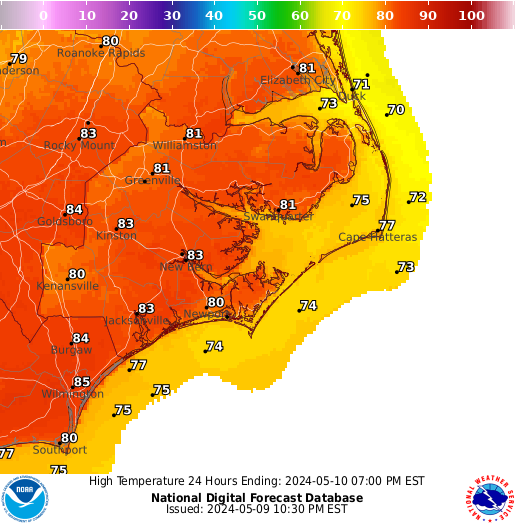Newport/Morehead City, NC
Weather Forecast Office
Datums
What is a datum?
It is simply a reference level, a zero surface to which storm surge heights are referred.
There are many several different datums:
Tidal datums: reference water levels defined by a phase of the tide.
Mean Sea Level (MSL)
Mean Lower Low Water (MLLW)
Mean Higher High Water (MHHW)
Geodetic datums: based on a simplified surface that represents the Earth’s shape and size.
North American Vertical Datum of 1988 (NAVD88)
National Geodetic Vertical Datum of 1929 (NGVD29)
Inundation is the total water level that occurs on normally dry ground as a result of storm tide, and is expressed in terms of height of water, in feet, above ground level (AGL). Inundation provides the most clearly and commonly understood method for communicating storm surge driven coastal flooding. The tidal datum MHHW (Mean Higher High Water) is the best possible approximation of the threshold at which inundation can begin to occur. Along the coast, areas higher than MHHW are typically dry most of the time.
Knowing your elevation and using a consistent datum is very important. When comparing water level observations (from tide stations) with other observations, observations with models or models to other models, you must always use consistent vertical datums in order to avoid misinterpreting surge elevations.
Back to Main Coastal Flooding Page
Hazards
Skywarn
Submit Local Storm Reports
National Storm Report Viewer
Storm Prediction Center
National Hurricane Center
Rip Currents
Forecasts
Text Products
Tropical Weather
Activity Planner
Map View
Text Forecast
Area Forecast Matrices
Point Forecast Matrices
Forecast Discussion
Aviation Forecasts
Fire Weather Forecasts
Climate/Historical
Local Climate Page
National Climate Data
Local Significant Event Summary
Climate Plots
Tropical Cyclone Reports
Observations
Mesonet
Buoy Observations
Area Rivers
UV Index
Air Quality
Other Marine Reports
Marine Information
Local Marine Forecast
National Marine Information
Surf Zone Forecast/Rip Currents
Area Tidal Predictions
Ocean Prediction Center
Experimental Marine Portal
US Dept of Commerce
National Oceanic and Atmospheric Administration
National Weather Service
Newport/Morehead City, NC
533 Roberts Rd
Newport, NC 28570
252-223-5737
Comments? Questions? Please Contact Us.


 Tropical Weather
Tropical Weather Map View
Map View Weather Hazard Briefing (when applicable)
Weather Hazard Briefing (when applicable) Forecaster Discussion
Forecaster Discussion Marine
Marine Text Products
Text Products.png) Skywarn
Skywarn Submit Storm Reports
Submit Storm Reports Coastal Flood
Coastal Flood